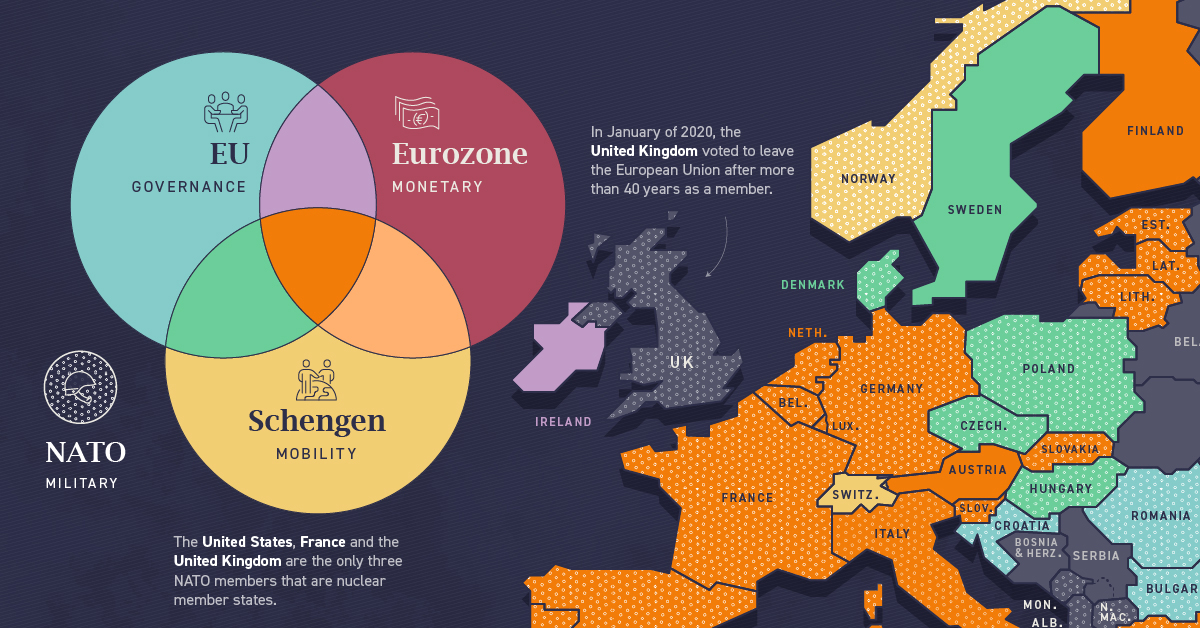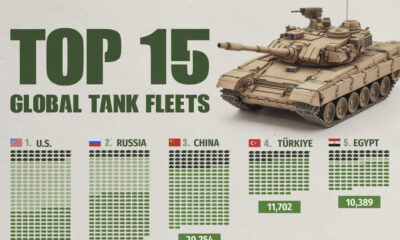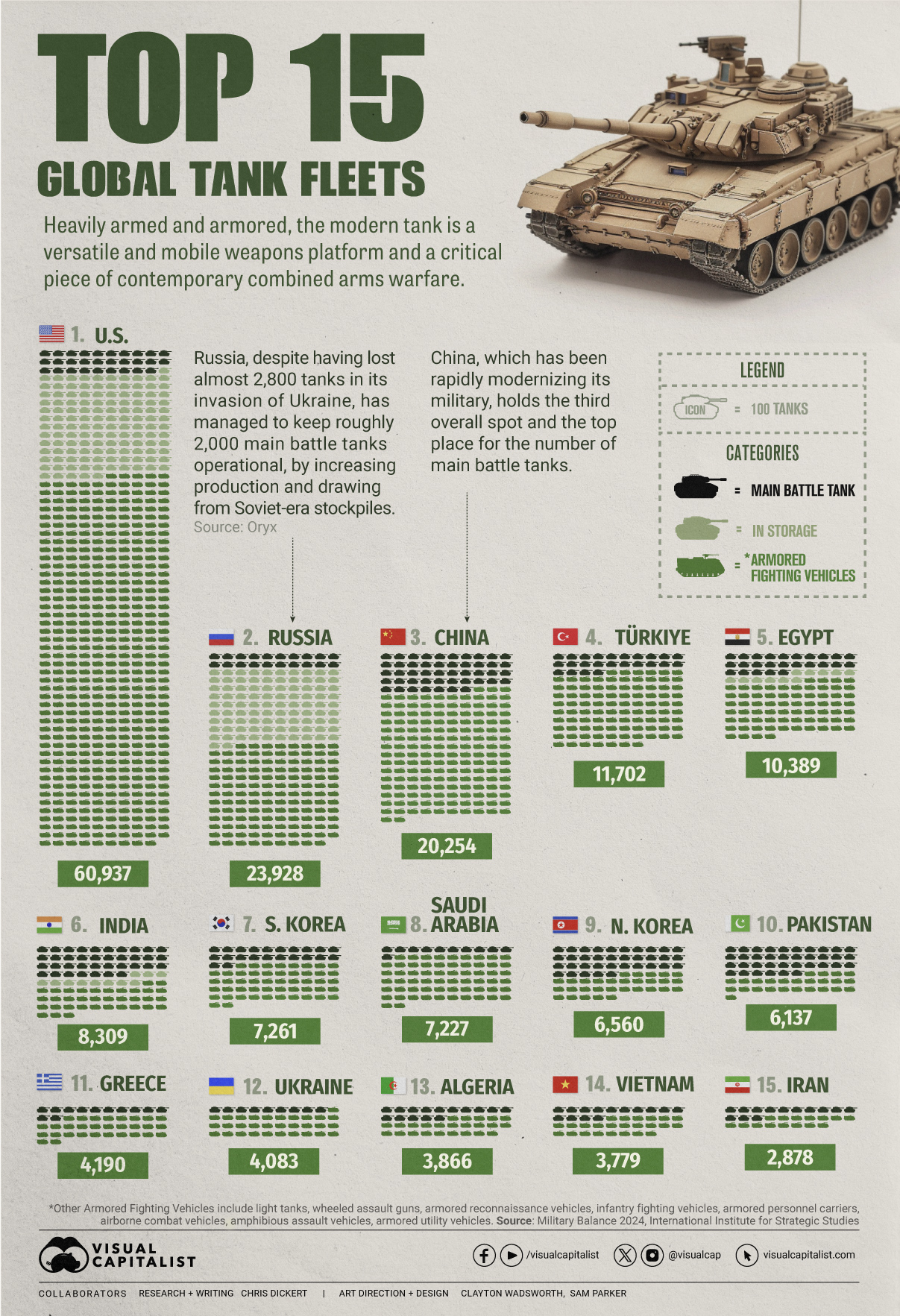Politics
A Visual Guide to Europe’s Member States
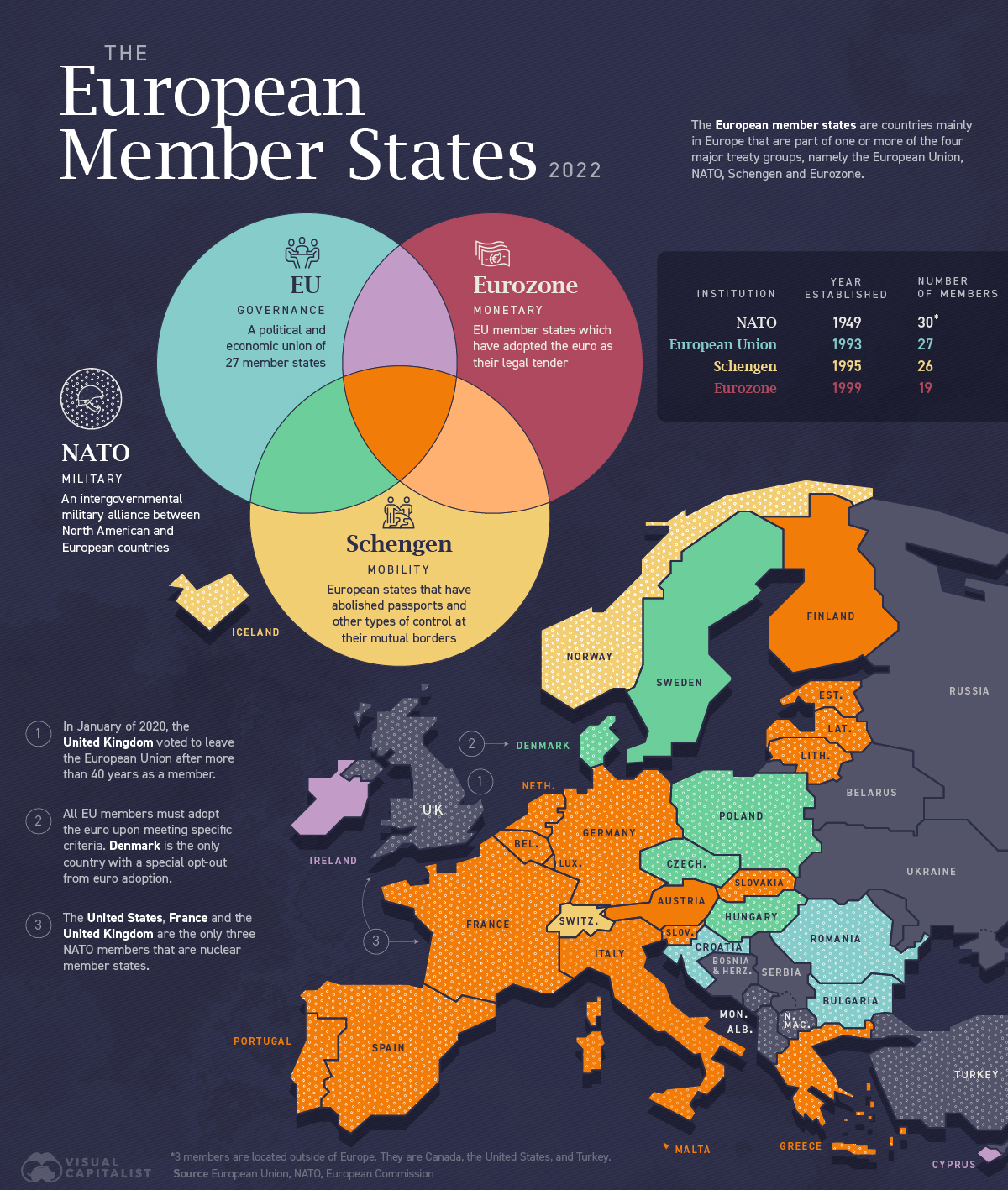
Who are Europe’s Member States?
With Ukraine’s recent bid to join the European Union (EU), the current status of Europe’s member states is back in the fray.
The European member states are countries mainly in Europe, and three outside, that are part of one or more of the four major treaty groups, namely the European Union (EU), NATO, Schengen, and eurozone.
Each of these institutions governs a different aspect of the region’s infrastructure.
Let’s take a look at each of them.
European Union
The European Union (EU) is a unique economic and political union between 27 European countries.
First created as the European Economic Community in the aftermath of WW2, the organization’s main focus was to foster economic cooperation. The idea was simple: countries that trade with one another and become economically interdependent are more likely to avoid conflict.
Beginning with six countries in 1958, the European Economic Community has since added 21 more countries (the UK left the EU in 2020), with a primary focus on single or internal markets.
Here are the countries that comprise the European Union:
| Number | Countries | Year of Accession |
|---|---|---|
| 1 | 🇦🇹 Austria | 1995 |
| 2 | 🇧🇪 Belgium | Founder |
| 3 | 🇧🇬 Bulgaria | 2007 |
| 4 | 🇭🇷 Croatia | 2013 |
| 5 | 🇨🇾 Cyprus | 2004 |
| 6 | 🇨🇿 Czech Republic | 2004 |
| 7 | 🇩🇰 Denmark | 1973 |
| 8 | 🇪🇪 Estonia | 2004 |
| 9 | 🇫🇮 Finland | 1995 |
| 10 | 🇫🇷 France | Founder |
| 11 | 🇩🇪 Germany | Founder |
| 12 | 🇬🇷 Greece | 1981 |
| 13 | 🇭🇺 Hungary | 2004 |
| 14 | 🇮🇪 Ireland | 1973 |
| 15 | 🇮🇹 Italy | Founder |
| 16 | 🇱🇻 Latvia | 2004 |
| 17 | 🇱🇹 Lithuania | 2004 |
| 18 | 🇱🇺 Luxembourg | Founder |
| 19 | 🇲🇹 Malta | 2004 |
| 20 | 🇳🇱 Netherlands | Founder |
| 21 | 🇵🇱 Poland | 2004 |
| 22 | 🇵🇹 Portugal | 1986 |
| 23 | 🇷🇴 Romania | 2007 |
| 24 | 🇸🇰 Slovakia | 2004 |
| 25 | 🇸🇮 Slovenia | 2004 |
| 26 | 🇪🇸 Spain | 1986 |
| 27 | 🇸🇪 Sweden | 1995 |
What began as a purely economic union has evolved into an organization pioneering the development of many different policy areas. A name change from the European Economic Community to the European Union in 1993 reflected this.
NATO
The North Atlantic Treaty Organization (NATO) exists for the sole purpose of facilitating a political and military alliance between its 30 member countries.
Established in 1949 in response to post-WW2 Soviet aggression, NATO exists for the collective defense and security of the group. Members share few laws and regulations. An attack on one constitutes an attack on all, and member states are obligated to defend one another.
The chronological timeline of NATO’s expansion since its establishment paints a fascinating picture.

As of 2021, NATO officially recognizes three aspiring NATO members: Bosnia and Herzegovina, Georgia, and Ukraine. Ukraine has voiced its desire to join NATO since 2014 but hasn’t met its political and military criteria.
Eurozone
The eurozone is a geographic and economic region that consists of countries that have adopted the euro as their national currency. Approximately 340 million people live in the euro area.
Today, the eurozone consists of 19 countries of the European Union. Here they are:
| Number | Countries | Year of Adoption |
|---|---|---|
| 1 | 🇦🇹 Austria | 1999 |
| 2 | 🇧🇪 Belgium | 1999 |
| 3 | 🇨🇾 Cyprus | 2008 |
| 4 | 🇪🇪 Estonia | 2011 |
| 5 | 🇫🇮 Finland | 1999 |
| 6 | 🇫🇷 France | 1999 |
| 7 | 🇩🇪 Germany | 1999 |
| 8 | 🇬🇷 Greece | 2001 |
| 9 | 🇮🇪 Ireland | 1999 |
| 10 | 🇮🇹 Italy | 1999 |
| 11 | 🇱🇻 Latvia | 2014 |
| 12 | 🇱🇹 Lithuania | 2015 |
| 13 | 🇱🇺 Luxembourg | 1999 |
| 14 | 🇲🇹 Malta | 2008 |
| 15 | 🇳🇱 Netherlands | 1999 |
| 16 | 🇵🇹 Portugal | 1999 |
| 17 | 🇸🇰 Slovakia | 2009 |
| 18 | 🇸🇮 Slovenia | 2007 |
| 19 | 🇪🇸 Spain | 1999 |
European Union nations that decide to participate in the eurozone must meet a multitude of financial requirements. They include price stability, sound public finances, the durability of convergence, and exchange rate stability.
Not all countries have to adopt the currency, though. For example, Denmark has a special opt-out clause to use its own currency and maintain its financial independence.
Schengen
The Schengen Area comprises 26 European countries that agreed to create common entry and exit requirements to remove the need for internal borders. This allows travellers up to 90 days of visa-free travel to any of the countries in the Schengen Area.
The border-free Schengen Area guarantees free movement to more than 400 million EU citizens, along with non-EU nationals living in the EU or visiting as tourists, exchange students, or for business purposes.
Here’s a list of the 26 countries that are a part of the Schengen Area:
| Number | Countries | Year of Implementation |
|---|---|---|
| 1 | 🇦🇹 Austria | 1997 |
| 2 | 🇧🇪 Belgium | 1995 |
| 3 | 🇨🇿 Czech Republic | 2007 |
| 4 | 🇩🇰 Denmark | 2001 |
| 5 | 🇪🇪 Estonia | 2007 |
| 6 | 🇫🇮 Finland | 2001 |
| 7 | 🇫🇷 France | 1995 |
| 8 | 🇩🇪 Germany | 1995 |
| 9 | 🇬🇷 Greece | 2000 |
| 10 | 🇭🇺 Hungary | 2007 |
| 11 | 🇮🇸 Iceland | 2001 |
| 12 | 🇮🇹 Italy | 1997 |
| 13 | 🇱🇻 Latvia | 2007 |
| 14 | 🇱🇮 Liechtenstein | 2011 |
| 15 | 🇱🇹 Lithuania | 2007 |
| 16 | 🇱🇺 Luxembourg | 1995 |
| 17 | 🇲🇹 Malta | 2007 |
| 18 | 🇳🇱 Netherlands | 1995 |
| 19 | 🇳🇴 Norway | 2001 |
| 20 | 🇵🇱 Poland | 2007 |
| 21 | 🇵🇹 Portugal | 1995 |
| 22 | 🇸🇰 Slovakia | 2007 |
| 23 | 🇸🇮 Slovenia | 2007 |
| 24 | 🇪🇸 Spain | 1995 |
| 25 | 🇸🇪 Sweden | 2001 |
| 26 | 🇨🇭 Switzerland | 2008 |
Monaco, Vatican City, and San Marino also have open borders with Schengen area countries even though they aren’t part of the treaty.
War
Visualized: Top 15 Global Tank Fleets
Heavily armed and armored, the modern tank is a versatile and mobile weapons platform, and a critical piece of contemporary warfare.
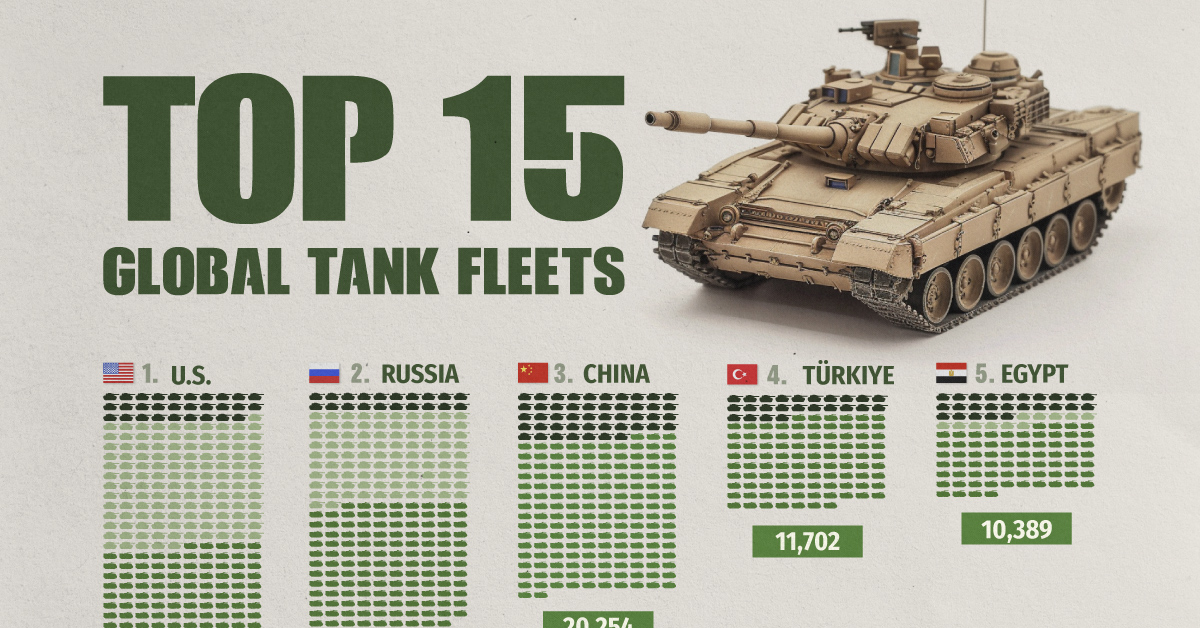
The Top 15 Global Tank Fleets
This was originally posted on our Voronoi app. Download the app for free on iOS or Android and discover incredible data-driven charts from a variety of trusted sources.
Heavily armed and armored, the modern tank is a versatile and mobile weapons platform, and a critical piece of contemporary warfare.
This visualization shows the top 15 global tank fleets, using data from the 2024 Military Balance report from the International Institute for Strategic Studies (IISS).
Let’s take an in-depth look at the top three fleets:
1. United States
As the world’s pre-eminent military power, it’s perhaps no surprise that the United States also has the largest tank fleet, by a wide margin.
In total, they have just over 45,000 armored fighting vehicles in operation, along with 2,640 main battle tanks (MBTs), and 12,800 vehicles in storage, of which 2,000 are main battle tanks.
| Category | Vehicles | Global rank |
|---|---|---|
| Main battle tanks | 2,640 | 4 |
| Armored reconnaissance | 1,745 | 1 |
| Infantry fighting vehicles | 3,262 | 3 |
| Armored personnel carriers | 10,644 | 1 |
| Amphibious assault vehicles | 1,401 | 1 |
| Armored utility vehicles | 28,445 | 1 |
| Storage | 12,800 | 1 |
| Total | 60,937 | 1 |
The U.S. is internalizing the lessons from the ongoing invasion of Ukraine, where Western-supplied anti-tank weapons and massed Ukrainian artillery have been cutting Russian tanks to pieces. As a result, the U.S. recently canceled an upgrade of the M1 Abrams in favor of a more ambitious upgrade.
Meanwhile, the U.S. is nervously eyeing a more confident China and a potential clash over Taiwan, where air and naval forces will be critical. However, a recent war game showed that Taiwanese mechanized ground forces, kitted out with American-made tanks and armored fighting vehicles, were critical in keeping the island autonomous.
2. Russia
According to Oryx, a Dutch open-source intelligence defense website, at time of writing, Russia has lost almost 2,800 main battle tanks since invading Ukraine. Considering that in the 2022 edition of the Military Balance, Russia was estimated to have 2,927 MBTs in operation, those are some hefty losses.
Russia has been able to maintain about 2,000 MBTs in the field, in part, by increasing domestic production. Many defense plants have been taken over by state-owned Rostec and now operate around the clock. Russia is also now spending a full third of their budget on defense, equivalent to about 7.5% of GDP.
At the same time, they’ve also been drawing down their Soviet-era stockpiles, which are modernized before being sent to the front. Just how long they can keep this up is an open question; their stockpiles are large, but not limitless. Here is what their storage levels look like:
| Category | 2023 | 2024 | YOY change |
|---|---|---|---|
| Main battle tanks | 5,000 | 4,000 | -20.0% |
| Armored reconnaissance | 1,000 | 100 | -90.0% |
| Infantry fighting vehicles | 4,000 | 2,800 | -30.0% |
| Armored personnel carriers | 6,000 | 2,300 | -61.7% |
| Total | 16,000 | 9,200 | -42.5% |
3. China
China holds the third overall spot and top place globally for the number of main battle tanks in operation. Untypically, the People’s Liberation Army has no armored vehicles in storage, which perhaps isn’t surprising when you consider that China has been rapidly modernizing its military and that stockpiles usually contain older models.
China also has one of the world’s largest fleets of armored fighting vehicles, second only to the United States. Breaking down that headline number, we can also see that they have the largest number of light tanks, wheeled guns, and infantry fighting vehicles.
| Category | Vehicles | Global rank |
|---|---|---|
| Main battle tanks | 4,700 | 1 |
| Light tanks | 1,330 | 1 |
| Wheeled guns | 1,250 | 1 |
| Infantry fighting vehicles | 8,200 | 1 |
| Armored personnel carriers | 3,604 | 5 |
| Airborne combat vehicles | 180 | 2 |
| Amphibious assault vehicles | 990 | 2 |
| Total | 20,254 | 3 |
This is equipment that would be integral if China were to make an attempt to reunify Taiwan with the mainland by force, where lightly armored mechanized units need to move with speed to occupy the island before Western allies can enter the fray. It’s worth noting that China also has one of the world’s largest fleets of amphibious assault vehicles.
End of the Tank?
Many commentators at the outset of Russia’s invasion of Ukraine, were quick to predict the end of the tank, however, to paraphrase Mark Twain, reports of the tank’s demise are greatly exaggerated.
With the U.S. and China both developing remote and autonomous armored vehicles, tanks could be quite different in the future, but there is nothing else that matches them for firepower, mobility, and survivability on the modern battlefield today.
-

 Green1 week ago
Green1 week agoRanked: The Countries With the Most Air Pollution in 2023
-

 AI2 weeks ago
AI2 weeks agoThe Stock Performance of U.S. Chipmakers So Far in 2024
-

 Markets2 weeks ago
Markets2 weeks agoCharted: Big Four Market Share by S&P 500 Audits
-

 Real Estate2 weeks ago
Real Estate2 weeks agoRanked: The Most Valuable Housing Markets in America
-

 Money2 weeks ago
Money2 weeks agoWhich States Have the Highest Minimum Wage in America?
-

 AI2 weeks ago
AI2 weeks agoRanked: Semiconductor Companies by Industry Revenue Share
-

 Travel2 weeks ago
Travel2 weeks agoRanked: The World’s Top Flight Routes, by Revenue
-

 Countries2 weeks ago
Countries2 weeks agoPopulation Projections: The World’s 6 Largest Countries in 2075




